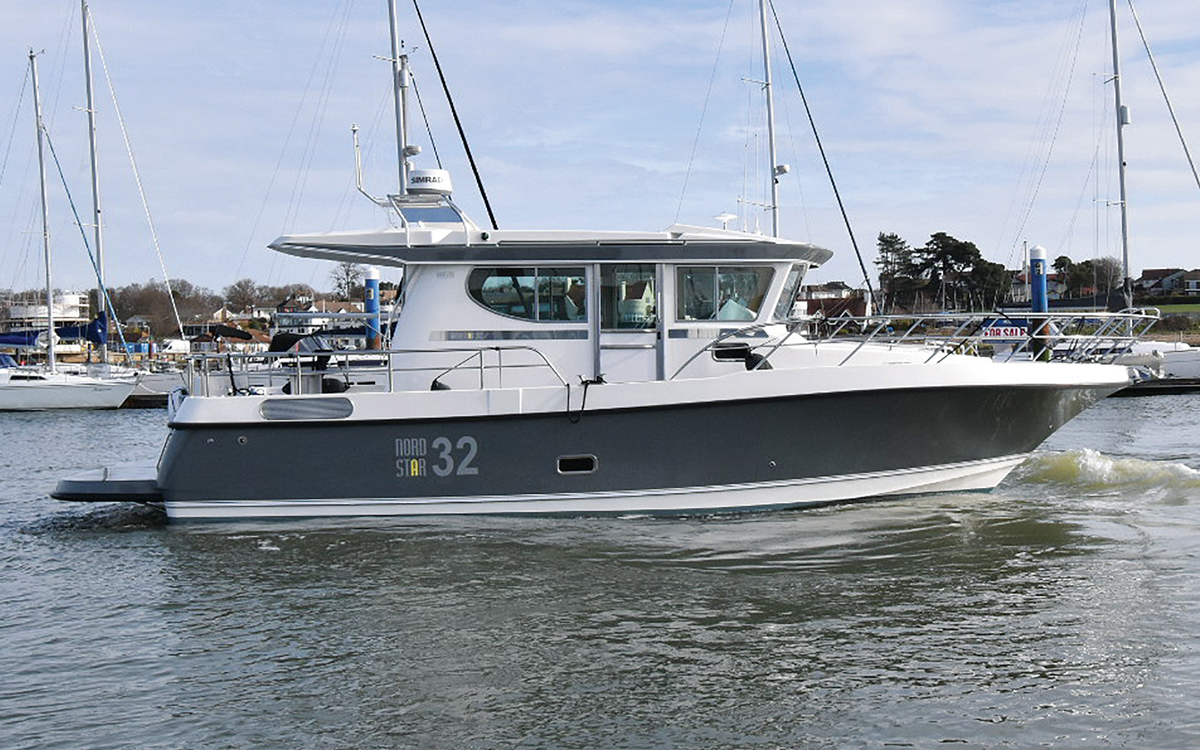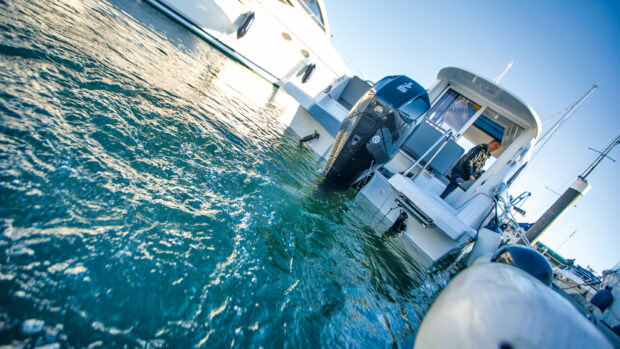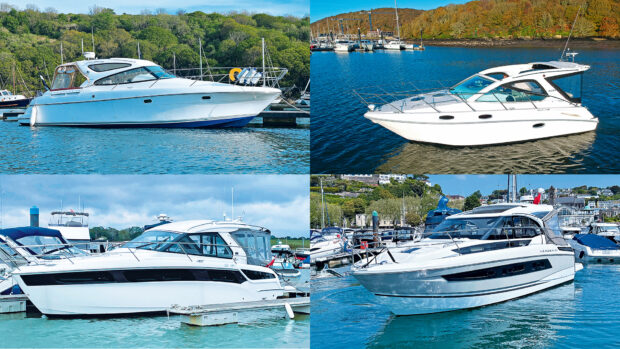Our resident used boat expert Nick Burnham picks out four great secondhand offshore boats that can handle any weather and keep on cruising.
Now in my fifties, I’m a committed fair weather sailor. I listen to other people’s tales of crossing the English Channel in a force seven with horror. “The waves were higher than the boat and we were shipping green water over the flybridge, it took 10 hours to get home but we made it. My wife wasn’t too keen, but I told her, that’s boating”.
These tales are often closely followed by the boat being put up for sale a few weeks later, occasionally it’s to fund the divorce. That said, I’ve done some big sea plugging in the past, and understand the grim satisfaction gained from taking on and conquering the elements, in the same way that I understand why people climb Mount Everest.
So if that’s your bag, good for you, here are four offshore boats worthy of the job. The right tool for this job might just save your life – and your marriage!
Article continues below…
Get a quote for your next boat

Botnia Targa 42
Built: 2006
Price: £240,000
It’s no surprise that we’re including a boat from Finland, land of the all-weather boater, and equally unsurprising that the boat in question is a Botnia Targa.
Launched in 2006, the 42 was the largest in the range when it was introduced, and in fact it still is – the Targa 44 that followed and current Targa 46 range topper evolved directly from this boat.
Interior
The quirky layout, quite unlike your typical circa 40ft flybridge boat, works rather well. The deck saloon is accessed via twin sliding doors close to the helm on the port and starboard sides, making this an easy boat to run short-handed.
Inside, it’s a riot of solid teak and practical thinking, with three seats abreast at the helm and the galley directly behind, opposite a large dinette with a table that slides out of the way up a pole to the ceiling.
Up front, the lower deck has a large double berth plus another single, and a separate heads. Aft you’ll find a second lower deck area with a double berth in the master cabin, another pilot berth that slots beneath the saloon and another heads.

Dinette features a table that stows away on the ceiling, maximising floor space
Exterior
The interior leaves plenty of exterior space for a low, wide walk-around deck that encircles the entire boat, making it incredibly easy to handle.
The cockpit is up forward in the bow leaving the aft deck free for other uses. There’s even a small flybridge with seating for three at the trailing edge of the wheelhouse roof.
Performance
Botnia stuck with outdrive propulsion as per the rest of its range. In this boat the engines are a pair of Volvo Penta D6-350s, the larger of the two options at launch (twin D6-310 was the alternative).
We achieved 35 knots on test with full fuel and water loads and five crew back in 2006. It’s efficient too, outdrives mated to a slippery hull create gains of up to 40% over conventional 40ft flybridge boats.

The forward double and heads are matched by a second cabin and heads at the aft end
Seakeeping
Botnia’s reputation was forged in rough sea ability, and the largest of the lot is therefore one of the best.
Specification
LOA: 44ft 4in (13.5m)
Beam: 13ft 0in (3.9m)
Draught: 3ft 1in (0.9m)
Displacement: 10 tonnes
Fuel capacity: 1,500 litres
Engines: Twin Volvo Penta D6-350 350hp diesel
Lying: Poole
Contact: Wessex Marine
Article continues below…

Botnia Targa 42 used boat: The ultimate SUV of the seas

Best all-weather boats: Our pick of the secondhand market
Seaward 42
Built: 2016
Price: £650,000
Built on the Isle of Wight, Seaward has a rich history of commercial pilot boats and harbour launches, offshore boats that have to put to sea irrespective of conditions. The leisure range spans from a 19ft launch through to this 42ft bruiser, all built with the same single-minded pursuit of offshore reach, come what may.
Interior
In a time where leisure boats get ever taller and fatter in order to squeeze in ever larger interior volume, the Seaward 42 is decidedly old school, giving the distinct impression that the company simply built the best hull and deck it could create, and then fitted out the interior space once it was finished.
But that said, the inside of this boat is far from an afterthought. Custom built to owner requirements, there are seven layout alternatives, this one featuring a vee-berth forward and a large converting dinette aft of it on the lower deck opposite a generous galley. The main deck is dominated by a pair of massive shock-mitigating helm seats port and starboard ahead of a saloon.

This model has been fitted with a capacious dinette on the lower deck
Exterior
The commercial roots show through in areas like the wide side decks, inner pilot rail and deep sided cockpit. This is a boat designed to be safe and easy to handle in all conditions and all circumstances. An M4 black rubber D section fender encircles the gunwale.
Performance
Standard engines are a pair of Yanmar 8LVs rated at 370hp. Options include the Yanmar 6LY-CRs, rated at 440hp, and the Cummins QSB 6.7’s rated at 425hp. This boat has the latter, which gave it 25.5 knots when we tested it.

Seven interior layouts are available, including a vee-berth forward
Seakeeping
A long deep keel dips to a depth of four feet beneath the waterline, protecting the sterngear and providing excellent directional stability. Part of the legendary Nelson hull design and backed up by an RCD Category A rating, it makes for a boat that led our test to conclude: “…and then there are boats like the Seaward 42, which truly can venture forth any time in any weather. The 42 is the real McCoy”.
Specification
LOA: 43ft 8in (13.3m)
Beam: 13ft 0in (4.0m)
Draught: 4ft 0in (1.22m)
Displacement: 14 tonnes
Fuel capacity: 2,000 litres
Engines: Twin Cummins QSB 6.7 425hp
Lying: Plymouth
Contact: Seaward Boats

Mersey Class ex-lifeboat
Built: 1987
Price: £75,000
If you’re going to be a bear, be a grizzly! It doesn’t get much more ‘Offshore Bruiser’ than an actual lifeboat, and that’s exactly what this is, a decommissioned Mersey Class. The RNLI introduced the Mersey Class in 1986. The concept followed the service’s desire for boats able to go faster than the 8 knots of vessels used in the 1960s and 1970s.
The answer was the Tyne Class launched in 1982 and capable of 17 knots, however at 26 tonnes it was too heavy for beach launching from a carriage. The aluminium-built Mersey was the answer. It became a mainstay of the RNLI until the Shannon Class was launched in 2014.
Interior
Functional best describes the interior of the Mersey Class. Light on high-gloss cherry and leather, but heavy on industrial looking navigation equipment, it’s a place of serious business, that of saving lives. There are two helm seats forward and a navigation station further back plus seats for a further two crew members and a bench seat aft.
On the lower deck, a survivor compartment can carry 43 people, but more than 21 prevents self-righting should the boat be capsized!

It may lack in bells and whistles but the Mersey Class is a serious offshore bruiser
Exterior
The decks are a sea of solid grey decking set off by the bright orange superstructure. At the back of the wheelhouse on the aft deck, a second helm station is more exposed but gives greater visibility for times when the helmsman needed all the help he could get to dodge into perilous situations and get back out again with survivors in sometimes horrific conditions.
Performance
Engines are a pair of Caterpillar 3208T diesel engines producing 280hp each at 2,800rpm. They gave this 14-tonne rescue boat a top speed of 17 knots.

A second helm station offers an optimal vantage point in rough seas
Seakeeping
We all hope we’ll never have to find out how good a lifeboat is at sea, but suffice to say, it was a design priority! Propellers are fully protected from damage when launching or in shallow water by partial tunnels and two bilge keels.
Specification
LOA: 38ft 1in (11.6m)
Beam: 13ft 1in (4.0m)
Draught: 3ft 3in (1.0m)
Displacement: 14 tonnes
Fuel capacity: 1,110 litres
Engines: Twin Caterpillar 3208T 280hp diesel
Lying: Isle of Wight
Contact: Richardsons Yacht Services Ltd

Nord Star 32
Built: 2019
Price: £295,000
It’s perhaps no surprise that we end this round-up of offshore bruisers with another Finnish vessel. The roots of this business date back to the 1920s, when Sivert Lindkvist started building wooden fishing and workboats.
His sons Rude and Sven introduced GRP leisure boats to the Nord Star range, and it is Rude’s son Olli Lindkvist who now heads up the business, based in Kälviä, Finland. Like the Botnia boats (and Sargo, another fine Finnish brand worthy of your consideration), the current Nord Star range is aimed squarely at functional all-weather all-season boating.
Interior
Although similar in concept to the Botnia range, when you get on board there are a number of very obvious fundamental differences. The one you’re likely to find first is a sliding door in the aft wheelhouse bulkhead, giving a third method of access and a direct route from inside to the aft deck.
Once inside, the saloon is lit by a large overhead electric sliding roof section as well as the windows and doors, further adding light and ventilation (with the roof and all doors open, it’s as connected to the elements as a wheelhouse boat is ever likely to be). And the galley is on the lower deck forward rather than part of the deck saloon, yet there are still two cabins with double beds (one accessed via a lifting section of the saloon seating).

Two double cabins are located on the lower deck, along with the galley
Exterior
On the outside, the cockpit is aft, protected by a long overhang that extends from the deck saloon roof. There are wide walk-around decks but no forward cockpit, instead the lower deck gets more headroom.
Performance
Single or twin engines are available, the largest giving an impressive 45 knot top end! This boat has a pair of Volvo Penta D4-300 motors that give it almost 40 knots and it cruises from low to mid-30 knots.

A sliding roof and large windows fill the saloon with natural light
Seakeeping
Finnish builders are renowned for build quality and seakeeping, and the Nord Star’s offshore performance reflects that. But it’s also very quiet due to its modern hull insulation, foam-filled beams and a thick hull.
Specification
LOA: 36ft 5in (11.4m)
Beam: 11ft 1in (3.4m)
Draught: 3ft 1in (0.9m)
Displacement: 7 tonnes
Fuel capacity: 615 litres
Engines: Twin Volvo Penta D4-300 300hp diesel
Lying: Southampton
Contact: MCC Marine
First published in the July 2020 edition of Motor Boat & Yachting.











